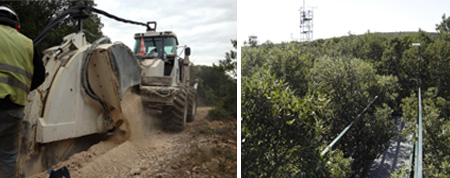The ExpeER call for Transnational Access (TA) proposals provides a unique opportunity for research teams and individuals to access some of Europe's major research infrastructures focused on ecosystem research. Each month, we will focus on one or two of these sites.
Focus on the Puechabon observational & experimental site (France)
INSTITUTE: CNRS CEFE UMR 5175
MAIN PURPOSE: Ecophysiological research, biogeochemistry, hydrology.
ECOSYSTEM TYPE: Overstorey of evergreen oak (Quercus ilex) with understory species of Buxus sempervirens and Juniperus oxycedrus.
EXPERIMENTAL TREATMENTS: Long-term 30% throughfall exclusion and thinning experiments and 100% rain exclusion at different seasons.
MORE INFORMATION: Map - About access, available facilities, supports offered and possible accommodation.
CONTACT: Serge Rambal (+33 (0)4 67 61 32 89)
Puechabon facilities
The site is located on a flat area 35 km North-West of Montpellier. The forest is dominated by the overstorey evergreen tree Quercus ilex (80% cover) managed as a coppice for centuries with the last clear-cut performed in 1942. Mean annual precipitation is 883 mm with 75 % rainfall between September and April. However, because of the large fraction of rocks and stones in the soil profile, available water averages only 150 mm. Long-term 30% throughfall exclusion and thinning experiments has started in 2003. In 2007 a new and unique manipulative experiment has been designed to simulate the effect of extreme droughts on the functioning and the vulnerability of this ecosystem. A mobile rainfall shelter was installed above the canopy in order to simulate 100% rain exclusion during different seasons.
Measurements recorded include soil and organ-level gas exchange; tree transpiration; aboveground and belowground biomass; phenology; functional traits; litterfall; regeneration; organs, soil and litter biochemistry; VOC emission; dry and wet nitrogen deposition; ectomycorhizal communities. The site also includes an eddy-flux tower that continuously monitors atmosphere-vegetation exchange of CO2, water and energy since 1998. A large number of papers have already been published from research at the site and an important database is already available for the users, which will help defining new research areas in the areas of population genetics, nutrient cycle, soil microbiology, isotope studies.

Pictures: apparatus used to trench the rocky soil ; scaffold running within the tree canopy with the tower flux.
New developments since the beginning of ExpeER
Spring 2013 is an important date for Puéchabon. First we are celebrating the tenth birthday of the partial rain exclusion. Because of the length of this exclusion we are sure that the climate in the ecosystem manipulation experiment has been changed even if the Mediterranean-type climate is one of the most impredictible of the Earth with its largest variability. Average rain amount has declined from 900 to 650 mm. A lot of interesting physiological and morphological acclimations have been identified for the above ground part of the Quercus ilex woodland and its understorey. Similarly, we suspect a lot of functions are changing in the nutrient cycling, in most soil processes and in fungi diversity. We welcome teams interested in such topics and the scaffolds of the experiments stretch out their arms towards potential applicants.
The second important event is that the site has been electrified. More than twoe kilometers of trench has been dug in the karstic rocky soil and now we could easily host research teams that need electric power that the previous solar plant did not permit. Last information concerning our site, the eddy flux tower has been upgraded to be part of the ICOS project.
Recent publications
Martin-StPaul, N. K., Limousin, J.-M., Vogt-Schilb, H., Rodríguez-Calcerrada, J., Rambal, S., Longepierre, D. and Misson, L. (2013) The temporal response to drought in a Mediterranean evergreen tree: comparing a regional precipitation gradient and a throughfall exclusion experiment. Global Change Biology. doi: 10.1111/gcb.12215
Limousin, J.-M., S. Rambal, J.-M. Ourcival, J. Rodriguez-Calcerrada, I. M. Perez-Ramos, R. Rodriguez-Cortina, L. Misson and R. Joffre (2012). "Morphological and phenological shoot plasticity in a Mediterranean evergreen oak facing long-term increased drought." Oecologia 169(2): 565-577.
Perez-Ramos, I. M., J. Rodriguez-Calcerrada, J. M. Ourcival and S. Rambal (2013). "Quercus ilex recruitment in a drier world: A multi-stage demographic approach." Perspectives in Plant Ecology Evolution and Systematics 15(2): 106-117.
Rodriguez-Calcerrada, J., J.-M. Limousin, N. K. Martin-StPaul, C. Jaeger and S. Rambal (2012). "Gas exchange and leaf aging in an evergreen oak: causes and consequences for leaf carbon balance and canopy respiration." Tree Physiology 32(4): 464-477.
Rodriguez-Calcerrada, J., I. M. Perez-Ramos, J.-M. Ourcival, J.-M. Limousin, R. Joffre and S. Rambal (2011). "Is selective thinning an adequate practice for adapting Quercus ilex coppices to climate change?"
Annals of Forest Science 68(3): 575-585.